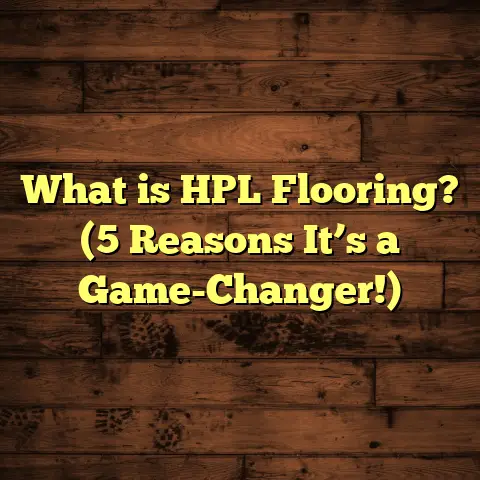What is Better: Marble Floor or Porcelain? (5 Key Comparisons Revealed)
“Quality is never an accident; it is always the result of intelligent effort.” – John Ruskin
When I first started working in flooring, this quote kept echoing in my mind. Choosing the right flooring material isn’t just about looks—it’s about making smart choices that stand the test of time, style, and budget. One question I get asked a lot is: What’s better—marble floors or porcelain tiles? Both are popular, elegant options, but each comes with its own set of strengths and challenges.
Let me walk you through five key comparisons between marble and porcelain flooring, backed by my experience on countless projects, real data, and some interesting case studies. Whether you’re planning a home renovation or a commercial project, these insights will help you make a clear decision.
What is Marble Flooring?
Marble flooring is a natural stone surface harvested from quarries around the world. It’s made from limestone that has undergone heat and pressure over millions of years, resulting in a beautiful crystalline structure. The look? Luxurious, unique veining patterns that no two slabs share.
Marble slabs typically come in sizes ranging from 12″x12″ tiles to large 24″x24″ or even 36″x36″ formats. Thickness varies from 3/8 inch for tiles to 3/4 inch for slabs used in high-end installations.
Marble is often sourced from famous locations like Carrara in Italy, Makrana in India, and Vermont in the USA. Prices vary greatly—on average, marble flooring costs about $40 to $100 per square foot installed, depending on the grade and origin. For example, Carrara marble usually falls on the lower end of this range, while rare varieties like Calacatta can push prices toward $150 per square foot.
In my projects, I’ve seen installation time for marble floors range from 3 to 7 days for an average-sized room (about 300 sq. ft.), considering the need for precise cutting, fitting, and sealing.
Marble flooring has been used for thousands of years. Ancient Roman and Greek architecture featured marble floors extensively, which speaks to its timeless appeal. When you walk on marble floors, you’re literally stepping on history.
The Natural Beauty and Variety of Marble
One of the things I love about marble is how every piece tells a different story. The veining patterns can be subtle whispers of grey and white or bold streaks of gold and black. This variety means marble can fit into many design styles—from classic to modern.
Common types of marble include:
- Carrara Marble: Mostly white or blue-grey with soft veining. It’s the most affordable and widely used.
- Calacatta Marble: Whiter background with thick, dramatic veins. Considered premium.
- Statuario Marble: A blend of Carrara and Calacatta features with bright white background and bold grey veins.
- Crema Marfil: Beige tones with gentle veins, offering warmth.
How Marble is Processed
Once quarried, marble blocks are cut into slabs using diamond wire saws. These slabs are polished to enhance their color and shine. Polished marble has a glossy finish that reflects light beautifully but can be slippery when wet.
Alternatively, honed finishes offer a matte look with less shine and better slip resistance but require more maintenance to avoid staining.
Marble’s porosity means it can absorb liquids if not sealed properly. Sealing fills the microscopic pores on the surface to prevent staining.
What is Porcelain Flooring?
Porcelain flooring is a type of ceramic tile made by firing fine clay at very high temperatures (over 1200°C). This process makes porcelain dense, durable, and highly resistant to moisture.
Porcelain tiles come in various sizes—common ones are 12″x12″, 18″x18″, and large-format tiles like 24″x24″ or even 24″x48″. Thickness usually ranges between 3/8 inch to 1/2 inch.
Porcelain is manufactured worldwide; major producers include Italy, Spain, China, and the USA. Costs for porcelain tile flooring generally range from $5 to $30 per square foot installed. Higher-end porcelain with special finishes or large formats can go up to $50 per square foot.
Installing porcelain floors usually takes less time than marble—often within 2 to 4 days for a typical room—thanks to easier cutting and handling.
Why Porcelain Became Popular
Porcelain gained popularity because it combines beauty with practical benefits like durability and ease of maintenance. Advances in digital printing allow manufacturers to replicate natural materials such as wood and stone at a fraction of the cost.
Porcelain’s low water absorption rate (<0.5%) makes it ideal for areas exposed to moisture like bathrooms, kitchens, and outdoor patios.
Types of Porcelain Tiles
- Glazed Porcelain: Has a glass-like coating that adds color and pattern. It’s easier to clean but can be slippery.
- Unglazed Porcelain: No glaze layer; naturally slip-resistant due to texture.
- Polished Porcelain: Polished after firing for a glossy finish mimicking natural stone.
- Textured/Matte Porcelain: Offers better traction for safety in wet areas.
1. Appearance & Aesthetic Appeal
Marble’s natural veining and glossy finish have long been associated with luxury. Each slab tells its own story with patterns that can be bold or subtle. I remember a client who fell in love with a slab of Carrara marble—the uniqueness was the selling point. It gave their foyer a timeless charm that porcelain can’t quite match.
Porcelain tiles can mimic marble’s look incredibly well now. With advanced printing technology, you get the elegance of marble without the imperfections or maintenance worries. However, if you look closely, porcelain patterns repeat because they are manufactured. Marble’s natural randomness means no two floors are alike.
If you want that authentic feel and can afford the upkeep, marble wins hands down on aesthetics. But porcelain offers a close alternative at a fraction of the cost.
Visual Differences in Detail
Marble surfaces have depth because their veins run through the stone itself. This creates a three-dimensional effect you can often feel by running your fingers over sealed surfaces.
Porcelain tiles use printed images on their surface. While visually similar from afar, up-close inspection reveals repeating patterns and sometimes pixelation depending on tile quality.
Case Study: Aesthetic Choices in a Luxury Home
I worked on a luxury home in Beverly Hills where the homeowner insisted on real marble despite its cost because they valued authenticity. The project included over 1,500 sq. ft. of Calacatta marble flooring in open-plan living spaces.
The client wanted every room distinctively beautiful yet cohesive; thus we chose different marble types for hallways versus main rooms to play with veining intensity.
Interestingly, neighbors later complimented how luxurious yet natural the floors looked compared to porcelain alternatives they had seen elsewhere.
2. Durability & Maintenance
Here’s where porcelain shines in my experience. Marble is softer and more porous compared to porcelain. It scores around 3–5 on Mohs hardness scale (where diamond is 10), while porcelain scores about 7 or higher.
Marble can scratch easily and stains if not sealed regularly—usually every 6 to 12 months depending on traffic and use. Acidic substances like vinegar or lemon juice etch marble surfaces quickly.
Porcelain is highly resistant to scratches, stains, and water penetration. It’s ideal for high-traffic areas or places prone to moisture (like kitchens and bathrooms). Porcelain tiles don’t need sealing, which saves time and money over years.
In one commercial project I worked on—a busy restaurant—porcelain floors maintained their pristine look after two years of heavy foot traffic and spills. A similar marble floor would have required constant maintenance.
Maintenance Routines Compared
- Marble: Requires regular sealing every six months to a year; cleaning with pH-neutral products; immediate wipe-up of spills; occasional polishing.
- Porcelain: No sealing needed; easy cleaning with water and mild detergents; highly stain-resistant.
Durability Data Points
- Marble hardness: Mohs scale ~3-5
- Porcelain hardness: Mohs scale ~7-8
- Water absorption: Marble ~0.4%-0.7%
- Water absorption: Porcelain <0.5% (often much less)
Marble’s porosity allows it to absorb oils or dyes if left untreated. Porcelain’s dense structure prevents this issue almost entirely.
3. Cost Comparison
Let’s talk numbers because budget usually drives decisions.
Marble:
- Material cost: $20–$70 per sq. ft.
- Installation: $15–$30 per sq. ft.
- Total: $35–$100+ per sq. ft.
Porcelain:
- Material cost: $3–$15 per sq. ft.
- Installation: $5–$15 per sq. ft.
- Total: $8–$30 per sq. ft.
That’s a significant difference, especially for large areas. With marble, you’re paying for natural stone rarity and craftsmanship during installation (cutting marble requires precision tools and experienced installers).
Porcelain is budget-friendly but still stylish if you pick quality tiles with good finishes.
Cost Breakdown Example – 500 sq. ft. Area
| Flooring Type | Material Cost | Installation Cost | Total Cost |
|---|---|---|---|
| Marble | $35/sq.ft | $20/sq.ft | $27,500 |
| Porcelain | $10/sq.ft | $10/sq.ft | $10,000 |
This example shows how marble can cost nearly three times as much as porcelain when fully installed.
How Location Affects Cost
Labor rates vary widely based on region:
- Urban areas like New York or San Francisco may have installation costs 20%-30% higher than rural zones.
- Access to quality marble quarries nearby (Italy vs USA) affects material costs.
- Shipping costs for heavy stone slabs add to marble expenses.
For porcelain, mass production reduces price variation across locations but local labor rates still influence total project cost.
4. Installation & Timeframe
Marble installation is labor-intensive. It requires careful substrate preparation because marble is heavy (about 160 lbs per cubic foot) and fragile during handling. Proper leveling matters—a slight unevenness can cause cracking later.
Expect an average installation timeframe of 4 to 7 days for a standard room (300 sq. ft.), including drying times for adhesives and sealers.
Porcelain tiles are lighter (about 110 lbs per cubic foot) and easier to cut using wet saws with diamond blades. This reduces installation time to roughly 2 to 4 days per room.
If you’re working on tight schedules or DIY projects, porcelain is more forgiving and efficient.
Installation Challenges with Marble
- Heavy slabs require multiple workers or machinery.
- Cutting requires specialized saw blades and water cooling systems.
- Polishing after installation adds extra time.
- Grout selection important for color matching.
- Sealing must be done post-installation (multiple coats sometimes).
Porcelain Installation Details
- Tiles come pre-cut; large-format tiles can be tricky but manageable.
- Thinset mortar adhesives used.
- Grout joints typically smaller than natural stone.
- No sealing needed post-installation.
- Faster drying times for adhesives reduce wait periods before use.
Real Project Timeline Comparison
At one renovation site I managed:
- Marble flooring took six days including sealing stages.
- Porcelain flooring took three days total from prep to completion.
The faster turnaround helped keep overall renovation on schedule.
5. Environmental Impact & Longevity
Marble is a natural product but quarrying impacts the environment significantly—large energy consumption and landscape disruption occur during extraction.
Porcelain production involves high-temperature kilns consuming fossil fuels but benefits from mass production efficiencies and recyclable materials in some cases.
Both materials last long if cared for: marble floors can last over 50 years with maintenance; porcelain can easily exceed that lifespan with minimal upkeep.
In my experience advising eco-conscious clients, porcelain’s durability with low maintenance often tips the scale due to less frequent replacements or repairs.
Environmental Considerations
| Factor | Marble | Porcelain |
|---|---|---|
| Raw material source | Natural quarries | Manufactured clay-based |
| Energy consumption | High during quarrying | High during firing |
| Waste generated | Quarry waste significant | Manufacturing scrap recyclable |
| Transportation impact | Heavy slabs mean higher fuel use | Lighter shipments |
| Longevity | Decades if maintained | Decades with minimal care |
Personal Experience & Case Study
A few years ago, I renovated an upscale villa in Miami where the client wanted marble floors throughout the living areas but porcelain tiles in the kitchen and bathrooms. The contrast worked beautifully.
The marble added unparalleled elegance but required constant sealing every six months because Miami’s humid environment accelerated wear.
In contrast, porcelain floors held up perfectly in wet zones without any extra care. Total project cost was about $65 per sq. ft., balancing luxury with practicality.
This mix-and-match approach might be worth considering if you want both beauty and durability without breaking your budget.
More Insights from My Projects
I once worked on a commercial office lobby where the client initially wanted all marble flooring for prestige reasons but was worried about maintenance downtime during business hours.
We proposed using polished porcelain tiles that mimicked Carrara marble instead for the main floor area while reserving actual marble for accent walls.
After two years:
- The porcelain floor showed zero wear or staining despite heavy foot traffic.
- The marble accent walls maintained their luxurious appeal but required periodic cleaning with specialty products.
- The client was happy with lower cleaning costs and less disruption overall.
How to Choose Based on Your Space
Ask yourself these questions:
- Is this floor going somewhere with high moisture or spills (kitchen/bathroom)?
- How much foot traffic will it face daily?
- What level of upkeep are you willing to commit?
- What’s your budget range?
- Do you prefer authentic natural stone or realistic look-alike?
For example:
| Use Case | Recommended Flooring |
|---|---|
| High-moisture areas | Porcelain |
| Low traffic luxury rooms | Marble |
| Budget-conscious zones | Porcelain |
| Outdoor patios | Porcelain (textured) |
| Statement foyers | Marble |
Advanced Tips for Both Flooring Types
Marble:
- Always seal after installation and annually thereafter.
- Use rugs or mats at entrances to minimize dirt abrasion.
- Avoid acidic cleaners that damage surfaces.
- Repair chips immediately with professional fillers.
Porcelain:
- Choose rectified edges for seamless grout lines.
- Opt for unglazed tiles in wet areas for better slip resistance.
- Use grout color matching tile shade for cleaner look.
- Clean regularly with mild detergent to keep shine intact.
Trends I’ve Noticed
Recently there’s been growing demand for large-format porcelain tiles that resemble marble but offer modern practicality—especially among younger homeowners who want style without hassle.
Meanwhile, luxury markets still prize rare marbles like Calacatta Gold for bespoke projects costing over $100 per sq.ft., especially in cities like New York, Dubai, or London where status symbols matter a lot.
Final Thoughts
So, what’s better? It depends on what matters most to you:
- If you want natural beauty, don’t mind higher cost, and are ready for maintenance—go with marble.
- If you prefer durability, lower cost, faster installation, and minimal upkeep—porcelain is your friend.
I hope sharing these insights helps you feel confident choosing your next floor! If you want detailed cost estimates tailored to your location or project size, tools like FloorTally can be super handy—they use local labor and material rates to give realistic budgets.
Got questions about specific brands or regional pricing? Just ask—I’m here to help!





